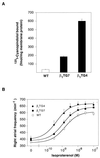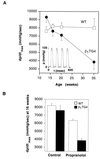Progressive hypertrophy and heart failure in beta1-adrenergic receptor transgenic mice
- PMID: 10359838
- PMCID: PMC22055
- DOI: 10.1073/pnas.96.12.7059
Progressive hypertrophy and heart failure in beta1-adrenergic receptor transgenic mice
Abstract
Stimulation of cardiac beta1-adrenergic receptors is the main mechanism that increases heart rate and contractility. Consequently, several pharmacological and gene transfer strategies for the prevention of heart failure aim at improving the function of the cardiac beta-adrenergic receptor system, whereas current clinical treatment favors a reduction of cardiac stimulation. To address this controversy, we have generated mice with heart-specific overexpression of beta1-adrenergic receptors. Their cardiac function was investigated in organ bath experiments as well as in vivo by cardiac catheterization and by time-resolved NMR imaging. The transgenic mice had increased cardiac contractility at a young age but also developed marked myocyte hypertrophy (3.5-fold increase in myocyte area). This increase was followed by progressive heart failure with functional and histological deficits typical for humans with heart failure. Contractility was reduced by approximately 50% in 35-week-old mice, and ejection fraction was reduced down to a minimum of approximately 20%. We conclude that overexpression of beta1-adrenergic receptors in the heart may lead to a short-lived improvement of cardiac function, but that increased beta1-adrenergic receptor signalling is ultimately detrimental.
Figures





Similar articles
-
Inhibition of Na(+)-H(+) exchange prevents hypertrophy, fibrosis, and heart failure in beta(1)-adrenergic receptor transgenic mice.Circ Res. 2002 Apr 19;90(7):814-9. doi: 10.1161/01.res.0000014966.97486.c0. Circ Res. 2002. PMID: 11964375
-
Early impairment of calcium handling and altered expression of junctin in hearts of mice overexpressing the beta1-adrenergic receptor.FASEB J. 2001 Dec;15(14):2718-20. doi: 10.1096/fj.01-0107fje. Epub 2001 Oct 15. FASEB J. 2001. PMID: 11606476
-
Altered calcium handling is critically involved in the cardiotoxic effects of chronic beta-adrenergic stimulation.Circulation. 2004 Mar 9;109(9):1154-60. doi: 10.1161/01.CIR.0000117254.68497.39. Epub 2004 Feb 16. Circulation. 2004. PMID: 14967726
-
Cardiac function in genetically engineered mice with altered adrenergic receptor signaling.Am J Physiol. 1997 Apr;272(4 Pt 2):H1553-9. doi: 10.1152/ajpheart.1997.272.4.H1553. Am J Physiol. 1997. PMID: 9139936 Review.
-
The beta-adrenergic receptors.Herz. 2002 Nov;27(7):683-90. doi: 10.1007/s00059-002-2434-z. Herz. 2002. PMID: 12439640 Review.
Cited by
-
Gαi2 signaling: friend or foe in cardiac injury and heart failure?Naunyn Schmiedebergs Arch Pharmacol. 2012 May;385(5):443-53. doi: 10.1007/s00210-011-0705-z. Epub 2012 Mar 14. Naunyn Schmiedebergs Arch Pharmacol. 2012. PMID: 22411356 Free PMC article.
-
Cardiovascular phenotype characterization in mice by high resolution magnetic resonance imaging.MAGMA. 2000 Nov;11(1-2):10-5. doi: 10.1007/BF02678482. MAGMA. 2000. PMID: 11186973 Review. No abstract available.
-
Anti-beta(1)-adrenergic receptor antibodies and heart failure: causation, not just correlation.J Clin Invest. 2004 May;113(10):1379-82. doi: 10.1172/JCI21748. J Clin Invest. 2004. PMID: 15146232 Free PMC article. Review.
-
Beta-arrestin-mediated beta1-adrenergic receptor transactivation of the EGFR confers cardioprotection.J Clin Invest. 2007 Sep;117(9):2445-58. doi: 10.1172/JCI31901. J Clin Invest. 2007. PMID: 17786238 Free PMC article.
-
Beta-adrenergic receptors in the failing heart: the good, the bad, and the unknown.J Clin Invest. 2001 Apr;107(8):947-8. doi: 10.1172/JCI12774. J Clin Invest. 2001. PMID: 11306597 Free PMC article. Review. No abstract available.
References
-
- Brodde O E. Pharmacol Rev. 1991;43:203–242. - PubMed
-
- Buxton I L, Brunton L L. Circ Res. 1985;56:126–132. - PubMed
-
- Bristow M R, Ginsburg R, Minobe W, Cubiciotti R S, Sageman W S, Lurie K, Billingham M E, Harrison D E, Stinson E B. N Engl J Med. 1982;307:205–211. - PubMed
-
- Ungerer M, Böhm M, Elce J S, Erdmann E, Lohse M J. Circulation. 1993;87:454–463. - PubMed
-
- Lohse M J. Biochim Biophys Acta. 1993;1179:171–188. - PubMed
Publication types
MeSH terms
Substances
LinkOut - more resources
Full Text Sources
Other Literature Sources
Medical
Molecular Biology Databases

